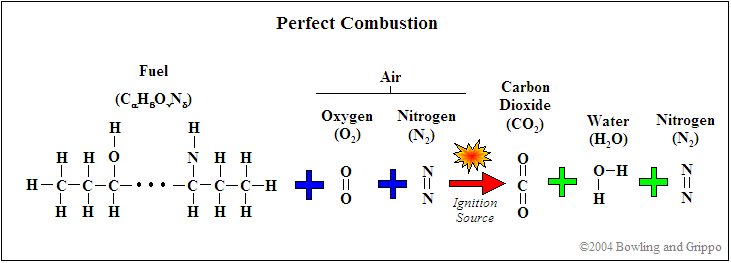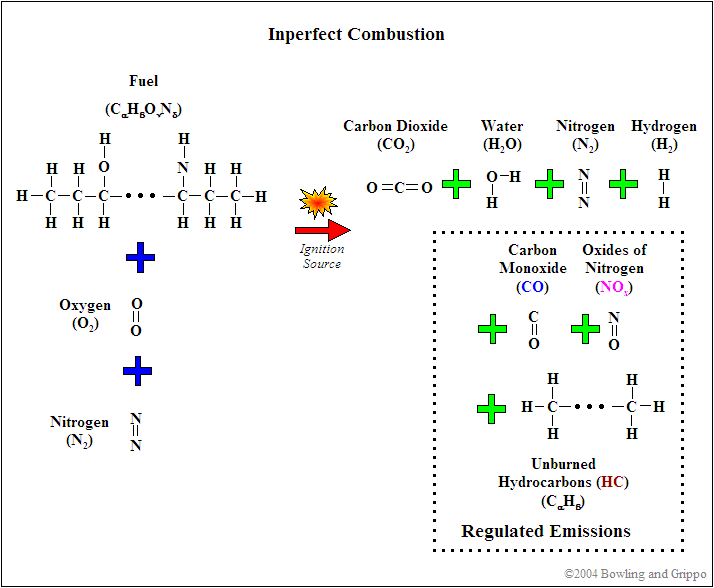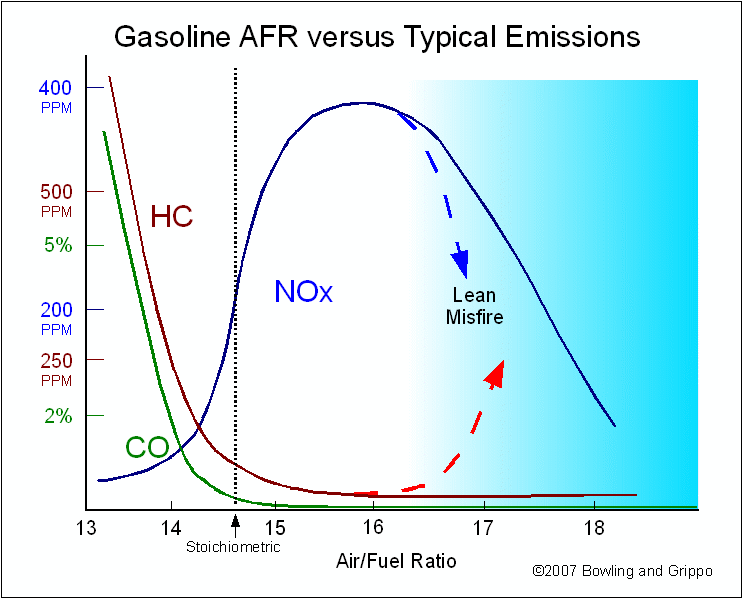

MegaSquirt® and MicroSquirt® controllers are experimental devices intended for educational and research purposes. MegaSquirt® and MicroSquirt® controllers are not for sale or use on pollution controlled vehicles. Check the laws that apply in your locality to determine if using a MicroSquirt® controller is legal for your application.
Automotive emissions occur in several forms:
Traditionally, gasoline is a complex mixture of hydrocarbons (molecules made up of hydrogen atoms on a chain of carbon atoms) of the form CαHβ. It might have trace amounts of nitrogen as well. Oxygen was not historically a part of the structure (though is often included now, more on this below!). The average ratio of carbon to hydrogen in the gasoline hydrocarbon mix is around 8 carbon atoms to 18 hydrogen atoms, i.e. C8H18. By the way, C8H18 is the formula for 'octane' ('oct' implies '8'), and is the basis of the 'octane rating' for knock.
A simplified chemical equation for perfect gasoline/air combustion (the ratio of fuel to air required for perfect combustion is known as stoichiometric (pronounced 'stoy-eék-ee-o-metric') is:
The oxygen (O2) is consumed from the intake air. Nitrogen (N2) is also present in the atmospheric air, but ideally does not participate in any reactions (it is quite inert at low temperatures). Note that the combustion products are carbon dioxide (CO2) and water (H2O), if the combustion is 'perfect'.

However, in the real world, not all the fuel burns:
As well, the heat of combustion may cause the normally inert nitrogen (N2) that composes ~80% of the intake air to break down and combine with oxygen, resulting in oxides of nitrogen emissions (NOx) - single nitrogen atoms with one or more oxygen atoms attached. (Note this is different from nitrous oxide, which is N2O, i.e. two nitrogen atoms are attached to one oxygen atom.) NOx is especially likely to be produced if the combustion temperature is high (high compression, etc.) and if the mixture is lean (because there is excess oxygen remaining even after burning all the fuel).
Finally, some of the fuel won't be able to combine completely with oxygen (which may be locally consumed within the combustion chamber - especially if the mixture is rich), and the result is carbon monoxide (CO) emissions.
So the 'real world' chemical equation for gasoline combustion looks more like:
The numbers on the right hand side (the products of combustion) vary considerably with operating conditions, a multitude of design factors, and fueling/ignition strategies.

There is a general relationship between the air/fuel ratio and the regulated tail pipe emissions put out by a given engine design:

What is Smog?Smog (a term originating in England from the days when coal and peat fired heating created a thick mixture of smoke and fog - "smog"!) is an accumulation of ozone and volatile organic compounds (called VOC) such as peroxyacetyl nitrate (PAN). These are referred to as 'secondary pollutants', because they are formed by the reaction of precursor pollutants emitted by burning fossil fuels, such as nitrogen oxides and hydrocarbons. The energy from sunlight makes the smog forming reactions possible. The result is photochemical smog, the brown haze in the sky that is especially prevalent on hot sunny days. To form photochemical smog, three main ingredients are needed: nitrogen oxides (NOx), hydrocarbons (HC), and energy from the sun in the form of ultraviolet light (which we will denote as hν = E - the energy of a photon). In the atmosphere, the nitric oxide resulting from gasoline combustion combines with atmospheric molecular oxygen to form nitrogen dioxide (NO2) within a few hours.
2 NO + O2 → 2 NO2
Nitrogen dioxide (NO2) absorbs sunlight energy and splits to form nitric oxide and atomic oxygen:
NO2 + hν → NO + O
Then, in sunlight, the atomic oxygen (O) combines with molecular oxygen gas (O2) to form ozone (O3):
O + O2 + hν → O3
If there were no other precursors present, ozone and nitric oxide would then react to form nitrogen dioxide and molecular oxygen:
O3 + NO ←hν→ NO2 + O2
This last reaction can proceed in either direction, depending on temperature and the amount of sunlight. If there is a lot of sunlight and the temperature is high, the equation moves to produce the products on the left, and more ozone is produced. However, engines also emit hydrocarbons (HC) as well as oxides of nitrogen. Hydrocarbons (HC) are the other main precursor forming photochemical smog (besides NOx). When hydrocarbons are present, nitric oxide (NO) preferentially reacts with them instead of reacting with the ozone. This reaction can produce a variety of toxic products, such as a volatile compound (VOC) known as PAN (peroxyacetyl nitrate), CH3COOONO2. (Organic compounds are all chemical compounds containing carbon-hydrogen (C-H) bonds of covalent character. The U.S. Environmental Protection Agency defines a VOC as any organic compound that participates in a photoreaction.) The reactions of NOX and unburned hydrocarbons (HC) are:
NO + HC → CH3COOONO2 and various other volatile organic compounds
NO2 + HC → CH3COOONO2 and various other volatile organic compounds
The result is that there are two problems created by the reaction of the tail pipe pollutants in the atmosphere:
The effects resulting from exposure to photochemical smog range from irritations of the respiratory tract (such as coughing and wheezing and breathing discomfort) and small biochemical or physiological changes, to severe breathing difficulties, markedly reduced lung capacity and efficiency, and aggravation of existing respiratory and cardiovascular conditions. Ozone affects lung functioning in a variety of ways, causing inflammation in the respiratory tract and damage to lung tissue, contributing to reduced inhalation capacity and lung function. Studies show there is no safe level of smog. Damaging health effects from exposure to smog can be caused by exposure to large concentrations over a short time span, or by chronic exposure to small amounts over long periods of time. In addition to the effect on human health, ozone can kill plant cells, reduce plant growth, and make plants more susceptible to damage from other causes. Oxidants such as ozone can also corrode and degrade many common materials such as rubber, nylon, fabric, and paint.
Acid RainIn addition to smog, automotive emissions can contribute to acid rain. In the air, nitric oxide (NO) is oxidized to nitrogen dioxide (NO2), which in turn reacts with water in the air to give nitric acid (HNO3). This acid dissociates in water to yield hydrogen ions and nitrate ions (NO3-) - i.e., acid rain!
Acid rain triggers a number of inorganic and biochemical reactions with harmful effects on the environment:
|
A catalytic converter can further reduce tail pipe emissions substantially below what the engine itself produces. This eliminates them from being able to become the precursors to photochemical smog in the atmosphere. A 3-way catalytic converter will support the following chemical reactions in the exhaust gas stream:
these can be combined as
2 NOX → N2 + X O2
where
(1 ≤ X ≤ 2)
The net result is that NOx, CO, and HC are reduced (while CO2 and H2O are increased somewhat).
However, the catalytic converter requires a near stoichiometric mixture to for maximum efficiency, because it only as a limited ability to store oxygen. If the mixture is too rich, there won't be enough oxygen to oxidize the unburned hydrocarbon and carbon monoxide. If the mixture is too lean, the oxides of nitrogen won't be completely reduced. ('Oxidation' is a chemistry term meaning to add oxygen to a molecule, 'reduction' is a chemistry term mean to remove oxygen from a molecule)
The catalytic converter must also reach its 'light off' temperature (around 400° to 600°F) before it will catalyze any of the above reactions - so getting it hot quickly is very important to reducing 'start-up' emissions. This often means a bit of a trade off - for example, retarded timing and a richer mixture to maximize the heat in the exhaust gases while warming up. (Manufacturers have be searching for a method to store converter heat on shut down (the operating temperature may reach 1200° to 1600°F) so it can be used to heat the converter on start up - a number of methods have been proposed, but none have been implemented in production vehicles at the time this is written, to our knowledge.)
The narrow band oxygen sensors are very sensitive to the exhaust gases that result from a stoichiometric mixture. Richer than stoichiometric (by as little as 0.2:1 AFR!) and they give a signal near 1 Volt. Leaner than stoich. and they give a signal near 0 volts. The result is that the narrow band sensor makes a good 'switch' to tell the fuel system to add or subtract fuel to meet the requirements of the catalytic converter for minimal emissions.
For research and educational purposes, properly tuning your engine for minimal emissions using a MegaSquirt® EFI controller generally requires expensive test equipment. However, as a rough initial plan for such a research program, you can:
Here is an example of how a few changes affected one engine:
| Baseline | Timing Retarded 10° |
Timing Advanced 10° |
Mixture richened |
Mixture leaned |
|
| HC | 1.00 | 0.78 | 1.14 | 1.39 | 0.88 |
| CO | 14.5 | 11.6 | 13.0 | 81.0 | 9.8 |
| NOx | 2.91 | 1.89 | 5.18 | 0.71 | 3.03 |
| O2 Not usually tested |
22.3 | 19.8 | 23.8 | 17.4 | 25.4 |
| CO2 Not usually tested |
305 | 307 | 298 | 246 | 310 |
You can see that retarding the timing and leaning the mixture slightly gives the best possible compromise, increasing only the NOx slightly among the regulated emissions. (The above was without a catalytic converter. With a converter, emissions would have been best at a stoichiometric mixture and the timing retarded somewhat.)